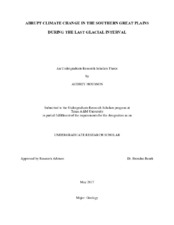| dc.description.abstract | Understanding how the climate of the North American Great Plains may change in the future is of tremendous socioeconomic importance, yet the regional response to previous abrupt global climate events, such as the Dansgaard-Oeschger (D/O) cycles of the last glacial interval, are poorly known. Here, we present two absolutely dated (U/Th), partially replicated oxygen isotope (δ18O) records from calcite speleothems in Central Texas (30° N, 98° W) that grew during marine isotope stage 3 (MIS 3) (31 to 49 ky BP). The study site experiences boreal spring and fall maxima in precipitation with rainfall moisture sourced almost exclusively from the Gulf of Mexico. The two samples exhibit reproducible δ18O means and variability during overlapping growth intervals. Weak correlations between paired oxygen and carbon isotopic values coupled with reproducible δ18O strongly suggest that dripwater δ18O and calcite formation temperatures are the primary drivers of speleothem δ18O variations through time. We interpret more depleted (enriched) δ18O values to reconstruct warmer and wetter (cooler and drier) conditions based on observations of modern rainfall stable isotope variations at the study site. We find that warmer and wetter conditions in the Southern Plains are contemporaneous with MIS 3 D/O interstadials, while cooler and more arid conditions prevail during stadials and Heinrich Events 4 and 5. Our results show a response opposite that of hydrologic reconstructions from the American Southwest, where wetter conditions occur during stadial conditions. Our speleothem data indicate that further intensification of rainy seasons in the Southern Plains should not be ruled out as a response to anthropogenic global warming. Future work includes exploration of paleoclimate model results to examine potential mechanisms responsible for this opposite phasing. | en |


